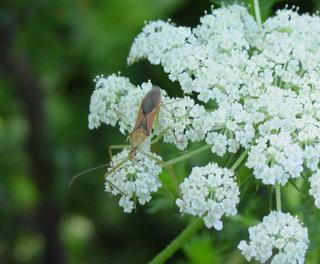 The assassin bug nymph from the 6/24 post is all grown up now, but still doing the same things. Here is an adult taken on 7/31, waiting for prey on a queen anne's lace flower. This is one of their favorite spots for catching flies, bees, or small butterflies. How long bugs spend in each of their life stages is important to know, along with their first emergence in the growing season. The nymph in my 6/24 post was well-developed, close to becoming adult. It has been 38 days since that photo was taken. What is the generation time for this species in mid-summer? How long do the adults live? Could this individual be the same one from 6/24, could it be a grand-daughter, or is it on a different life line altogether?
The assassin bug nymph from the 6/24 post is all grown up now, but still doing the same things. Here is an adult taken on 7/31, waiting for prey on a queen anne's lace flower. This is one of their favorite spots for catching flies, bees, or small butterflies. How long bugs spend in each of their life stages is important to know, along with their first emergence in the growing season. The nymph in my 6/24 post was well-developed, close to becoming adult. It has been 38 days since that photo was taken. What is the generation time for this species in mid-summer? How long do the adults live? Could this individual be the same one from 6/24, could it be a grand-daughter, or is it on a different life line altogether?As summer progresses, it's common
 to see more life stages of an insect species present concurrently, until winter (the great equalizer) resets the starting line for the following spring. Here's another view of one of these adult assassin bugs, taken Aug 9. Maybe this is the same one, since it is on the same flower. This is 47 days since the first photo of the nymph. How far do they travel during their short lives? Is it likely one's entire existence would be spent on the same rudbeckia plant?
to see more life stages of an insect species present concurrently, until winter (the great equalizer) resets the starting line for the following spring. Here's another view of one of these adult assassin bugs, taken Aug 9. Maybe this is the same one, since it is on the same flower. This is 47 days since the first photo of the nymph. How far do they travel during their short lives? Is it likely one's entire existence would be spent on the same rudbeckia plant?
1 comment:
Eric Eaton at BugGuide thinks this is a member of genus Zelus; I'm inclined to agree.
Post a Comment